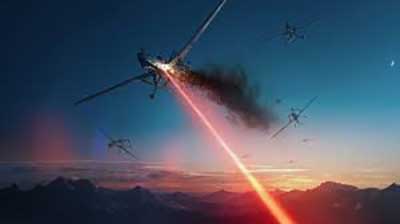GS-3 Science and Technology- developments
Key Phrases: DEW, laser Weapon, Microwave weapon, KALI, DURGA II,
Why in News?
- The U.S. Navy announced on Wednesday it tested a laser weapon and destroyed a floating target in West Asia, a system that could be used to counter bomb-laden drone boats deployed by Yemen’s Houthi rebels in the Red Sea.
What is a Directed Energy Weapons (DEW)?
A DEW is a weapon that destroys, damages or incapacitates its target with highly focused energy, including laser, microwaves or particle beams.

Types of DEW:
- LASER Weapon Systems (LaWS): As the name suggests, laser weapons are based on laser beams fired from an apparatus. Although it’s offensive application haven’t been demonstrated so far, it has been used in other auxiliary applications such as the designation of high-value targets for air-strikes and guiding missiles.
- Microwave DEW. Any weapon which has a microwave range between 300 MHz and 300 GHz is generally classified as a microwave weapon. These DEW disrupt electronic components and can produce graduated effects, depending upon the amount of energy that is directed. Some examples of weapons which have been publicised are as follows:
- Active Denial System, which is a millimetre wave source that heats the water in a human target’s skin and thus causes incapacitating pain.
- Bofors HPM Blackout a high-powered microwave weapon that is said to be able to destroy at a short distance a wide variety of commercial electronic equipment.
- Particle-Beam DEW. Particle-beam DEW use a directed flow of charged or neutral particles as a damaging factor. In the 1970s, the US was simultaneously developing beam based devices of various kinds along with other DEW. These DEW find application against ground forces, in aviation and for targeting space- based assets.
- Plasma DEW. Plasma DEW fire a beam stream of plasma, which is an excited state of matter consisting of atomic nuclei and free electrons. This DEW offered long-range LASER accuracy, high rate of fire and “scalable effects,” meaning that its lethality could be adjusted.
- Sonic DEW. Sonic DEW use sound as a means to injure, kill or incapacitate. These DEW function in the frequency range of 1 Hz to 30. The Nazis reportedly developed a sonic cannon capable of shooting down allied bombers.
- Directional Atom. This idea involves the creation of a special atomic warhead that transfers most of the explosion energy in a given direction. The most famous development is the American Project Casaba, on which work began in the 1950s.
Some ongoing/ future projects in India:
- DRDO’s Counter IED 1 KW LASER – enables remote disposal of unexploded bombs, mines and IEDs. The system’s effective range is 30-250 m.
- Kilo Ampere Linear Ejector (KALI) – a particle accelerator DEW being developed by DRDO and Bhabha Atomic Research Center. This DEW will emit powerful electron pulses aimed towards destruction of incoming missiles and aircraft by destroying on- board electronic circuits.
- DRDO’s Laser Science and Technology Centre (LASTEC) is working on Project Aditya under which it is developing gas dynamic high power 100 kw LaWS.
- Directionally Unrestricted Ray-Gun Array (DURGA II), will see the Indian Army receive a 100-kilowatt, lightweight LaWS. The program is slated to be integrated with land, sea and air-based platforms and is currently reportedly in the concept stage. In addition, DRDO is also reportedly working on IR dazzlers to take on enemy aircraft and helicopters at 10 km and 25-kw LaWs to destroy missiles during their terminal phase at range of 5 to 7 km.
Advantage of Directed Energy Weapons (DEW):
- Such weapons can be deployed stealthily and if used right with comparatively less collateral damage.
- Logistical problems of procuring more ammunition are eliminated as the surplus amount of energy is all that is needed
- Cheaper to operate than conventional weapons depending on certain operational factors
Disadvantage of Directed Energy Weapons (DEW):
- The research into DEW’s is a financially draining task
- The practical applications of some DEW’s are questionable
- Counter against such weapons is not hard to come by. For example, laser beams can be weakened by water vapour and dust.
Way Forward:
- The drone attacks in Jammu Airbase on 27 June should be a wakeup call for India’s security establishment and the decision makers. Such attacks are likely to increase in due course as both military and non-state actors including terrorists will opt for safer and cheaper options to target critical assets or spread panic. Anti-drone systems and DEW could be the suitable answer for such future threats. DEW provides a number of capabilities and advantages over traditional weapons due to speed-of-light delivery, precision engagement, controlled/scalable effects, logistical benefits of minimal replenishment and low cost per shot.
Source: The Hindu
Mains Question:
Q. What do you understand by Directed Energy Weapons and it various types? Is India developing these types of weapon? Explain it with example.







